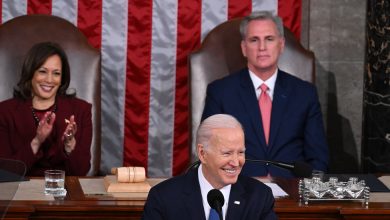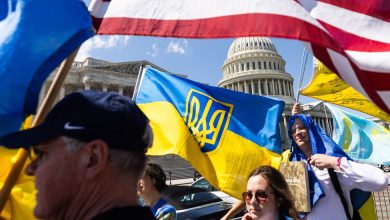How the Ukraine Crisis Developed, and Where It Might Be Headed

It feels like a scene from the Cold War. An unpredictable Russian leader amassing troops and tanks on a neighbor’s border. The threat of a bloody East-West conflagration.
But what seems like a perilous episode from a bygone era is now front and center in global affairs. After a meeting with European leaders on Feb. 11, the White House warned that Russia could start a full-scale invasion of Ukraine in less than a week.

Map: Where Russian Troops Are Positioned Around Ukraine
An estimated 130,000 Russian troops are in position on Ukraine’s northern, eastern and southern sides.
U.S. officials say Russia’s buildup has reached 130,000 troops. They say they have evidence of a Russian war plan that envisions an invasion force of 175,000 troops that Ukraine’s military, despite U.S.-provided equipment and training, would have little ability to stop.
Some 8,500 American troops are on “high alert” for possible deployment to Eastern Europe, most likely to provide assurance to American allies in the region.
A military action threatens to destabilize the already volatile post-Soviet region, with serious consequences for the security structure that has governed Europe since the 1990s.
Russia has made a list of far-reaching demands to reshape that structure — positions NATO and the United States has rejected. Russian officials have repeatedly insisted that Moscow has no plans to invade Ukraine, but Mr. Putin pointedly has not ruled it out.
What’s behind the Ukraine crisis?
After the Soviet Union collapsed, NATO expanded eastward, eventually taking in most of the European nations that had been in the Communist sphere. The Baltic republics of Lithuania, Latvia and Estonia, once parts of the Soviet Union, joined NATO, as did Poland, Romania and others.
As a result, NATO, an alliance created to counter the Soviets, moved hundreds of miles closer to Moscow, directly bordering Russia. And in 2008, it stated that it planned — some day — to enroll Ukraine, though that is still seen as a far-off prospect.
Mr. Putin has described the Soviet disintegration as a catastrophe that robbed Russia of its rightful place among the world’s great powers and put it at the mercy of a predatory West. He has spent his 22 years in power rebuilding Russia’s military and reasserting its geopolitical clout.
The Russian president calls NATO’s expansion menacing, and the prospect of Ukraine joining it an existential threat to his country. As Russia has grown more assertive and stronger militarily, his complaints about NATO have grown more strident. He has repeatedly invoked the specter of American ballistic missiles and combat forces in Ukraine, though U.S., Ukrainian and NATO officials insist there are none.
Mr. Putin has also insisted that Ukraine and Belarus are fundamentally parts of Russia, culturally and historically. He holds considerable sway over Belarus, and talks about some form of reunification with Russia have gone on for years.
But East-West relations worsened drastically in early 2014, when mass protests in Ukraine forced out a president closely allied with Mr. Putin. Russia swiftly invaded and annexed Crimea, part of Ukraine. Moscow also fomented a separatist rebellion that took control of part of the Donbas region of Ukraine, in a war that still grinds on, having killed more than 13,000 people.
A 2015 cease-fire agreement on Donbas could give Russian proxies veto power over much of Ukrainian policy, including in foreign affairs. But with the war making Russia more unpopular in Ukraine, and both sides accusing each other of violating the accord, it has never been fully implemented.
What does Mr. Putin want?
Mr. Putin appears intent on winding back the clock more than 30 years, establishing a broad, Russian-dominated security zone resembling the power Moscow wielded in Soviet days. Now 69 years old and possibly edging toward the twilight of his political career, he clearly wants to draw Ukraine, a nation of 44 million people, back into Russia’s orbit.
Less clear is how willing he is to do it by force if the cost to Russia is high, and whether he would be content with a Ukraine that is pliant but remains apart from Russia.
Russia presented NATO and the United States in December with a set of written demands that it said were needed to ensure its security. Foremost among them are a guarantee that Ukraine would never join NATO, that NATO draw down its forces in the Eastern European countries that have already joined, and that the 2015 cease-fire in Ukraine be implemented — though Moscow and Kyiv disagree sharply on what that would mean.
The West dismissed the main demands out of hand, while making overtures on other concerns, and threatening sanctions. Moscow’s aggressive posture has also inflamed Ukrainian nationalism, with citizen militias preparing for a drawn-out guerrilla campaign in the event of a Russian occupation.
Mr. Putin’s timing could also be related to the transition from President Donald J. Trump, who was notably friendly to him and disparaging of NATO, to President Biden, is committed to the alliance and distrustful of the Kremlin.
He may also want to energize nationalist at home support by focusing on an external threat, as he has in the past. Mr. Putin has crushed domestic challenges to his authority, but last year, with the economy stumbling and the pandemic raging, opposition groups held some of the largest anti-Putin protests in years.
How does the United States plan to respond?
The White House warned on Feb. 11 that Mr. Putin could mount a major assault on Ukraine as early as Feb. 16, having closed in on Ukraine with land, sea and air forces on three sides. Officials acknowledged the possibility that mentioning a particular date could be part of a Russian disinformation effort.
U.S. officials still do not know whether Mr. Putin has decided to invade, but Jake Sullivan, the president’s national security adviser, insisted, “We are ready either way.”
Understand the Escalating Tensions Over Ukraine
A brewing conflict. Antagonism between Ukraine and Russia has been simmering since 2014, when the Russian military crossed into Ukrainian territory, annexing Crimea and whipping up a rebellion in the east. A tenuous cease-fire was reached in 2015, but peace has been elusive.
A spike in hostilities. Russia has been gradually building up forces near its border with Ukraine, and the Kremlin’s messaging toward its neighbor has hardened. Concern grew in late October, when Ukraine used an armed drone to attack a howitzer operated by Russian-backed separatists.
Preventing an invasion. Russia called the strike a destabilizing act that violated the cease-fire agreement, raising fears of a new intervention in Ukraine. Since then, the United States, NATO and Russia have been engaged in a whirlwind of diplomacy aimed at averting that outcome.
The Kremlin’s position. President Vladimir V. Putin of Russia, who has increasingly portrayed NATO’s eastward expansion as an existential threat to his country, said that Moscow’s growing military presence on the Ukrainian border was a response to Ukraine’s deepening partnership with the alliance.
Rising tension. Western countries have tried to maintain a dialogue with Moscow. But the Biden administration warned that the U.S. could throw its weight behind Ukraine in case of an invasion. France, Germany and Poland also warned Russia of consequences if it launched incursions into Ukraine.
In early December, Mr. Biden made clear that his administration was not considering sending troops to fight for Ukraine, since, among other reasons, Ukraine is not a member of the NATO alliance and does not come under its commitment to collective defense.
Instead, the United States has sent anti-tank and antiaircraft weapons to Ukraine, increased the American military presence in NATO countries that border Russia, and put 8,500 troops on high alert for deployment to Eastern Europe. Administration officials have also warned recently that the United States could throw its weight behind a Ukrainian insurgency should Mr. Putin invade Ukraine.
But the core of Mr. Biden’s response has been to threaten Mr. Putin with “economic consequences like none he’s ever seen,” while keeping diplomatic channels open and trying to corral all of the NATO allies behind a unified policy.
The most severe economic blow the United States could deliver would be to cut Russia off from the international banking system. Mr. Biden has said that a Russian invasion would spell the death of one of Moscow’s prized projects, the $11 billion Nord Stream 2 to increase natural gas exports to Europe.
The administration would try to freeze personal assets that Mr. Putin and his allies hold overseas, officials say, and it could institute sanctions that could deprive Russians of their beloved next-generation phones, laptops and other gadgets, and the military of advanced equipment.
In response to Russia’s demands, American officials have offered measures like talks on nuclear arms control, greater transparency in military exercises, which their Russian counterparts have called worthwhile, but not central. European leaders are holding their own talks with Moscow, though the details remain closely guarded.
An intensifying conflict in Ukraine would test the resolve of the Biden administration, which has been working to restore confidence in America’s global leadership following the recent messy withdrawal from Afghanistan and its retrenchment from foreign engagements under Mr. Trump, who declared NATO “obsolete.”
An escalating conflict with Russia also threatens to upend recent efforts by the United States to shift NATO’s attention to the security challenge posed by China.
What’s at stake for Europe?
At stake for Europe is whether it can allow Mr. Putin to upend the security structure that has helped keep the peace on the continent since World War II. And with Europeans divided over how to respond to various forms of Russian aggression, the conflict has also laid bare the fractures within the European Union and NATO.
With the departure of Chancellor Angela Merkel, who grew up in the east, speaks fluent Russian, and had developed a good working relationship with Mr. Putin, Europe lost an invaluable interlocutor with Moscow. Her successor, Olaf Scholz, has been criticized for not taking a prominent role in the crisis.
Europe has important trade ties with Russia, and would stand to lose far more than the U.S. from sanctions imposed after a Russian invasion of Ukraine. It is also dependent on Russian gas supplies, a weakness that Mr. Putin has exploited in past disputes.
Steven Erlanger in Brussels contributed reporting.





